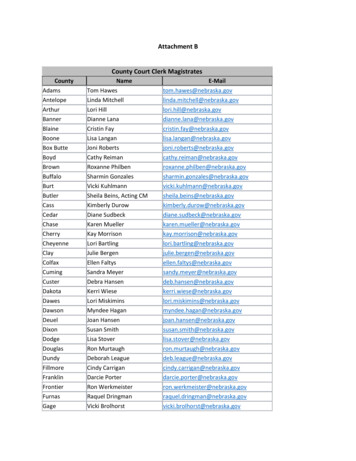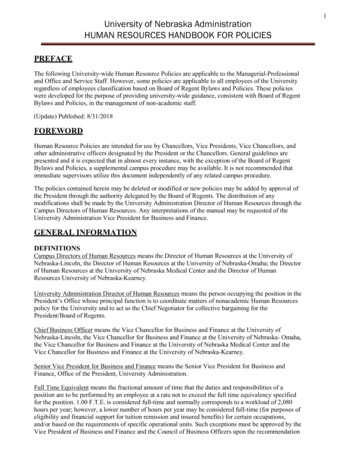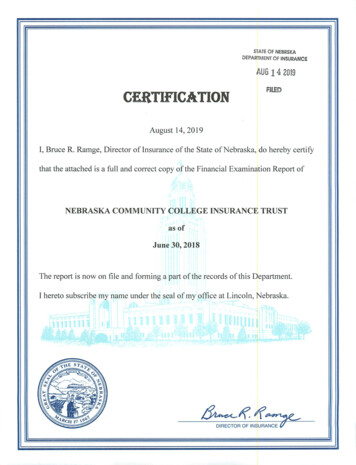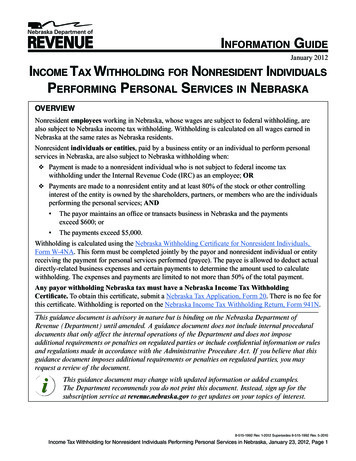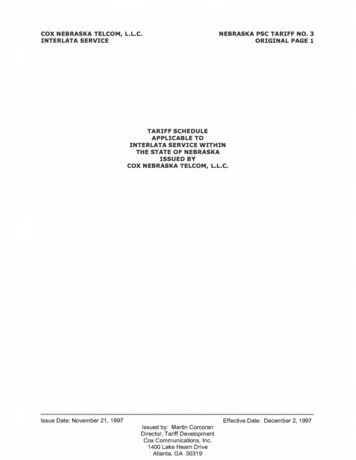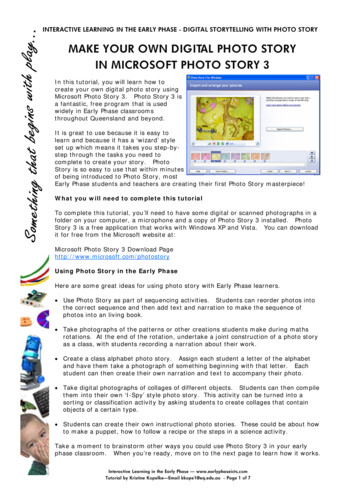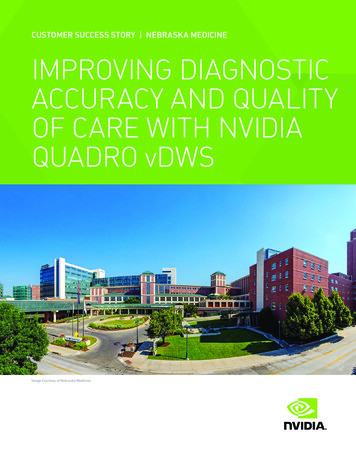
Transcription
CUSTOMER SUCCESS STORY NEBRASKA MEDICINEIMPROVING DIAGNOSTICACCURACY AND QUALITYOF CARE WITH NVIDIAQUADRO vDWSImage Courtesy of Nebraska Medicine
VIRTUAL GPU-ENABLED VDI BALANCES USEREXPERIENCE, COST, AND FLEXIBILITYINTRODUCTIONNebraska Medicine is an academic health organization of hospitals,specialty medical clinics, and healthcare colleges. With facilities locatedin Omaha and surrounding areas, it is Nebraska’s largest healthcareorganization tracing its roots back to 1869 and the founding of Omaha’sfirst hospital. The organization has earned an international reputationfor developing breakthrough cancer care, organ transplantation andtreatment of infectious diseases, and has been named one of America’sbest hospitals by U.S. News & World Report.Image Courtesy of Nebraska MedicineSUMMARY Nebraska Medicine is the state’s largesthealthcare organization with more than8,000 employees and physicians. Deploying hyperconverged infrastructureprovided an opportunity to upgrade its VDI. Intense IT workloads and maintenanceneeds made the radiology department anideal internal test candidate for upgradedvirtual GPU-enabled VDI. Nebraska Medicine deployed DellPowerEdge R740 servers with NVIDIA Quadro Virtual Data Center Workstation(Quadro vDWS) and Tesla M10 cards. 100 radiology stations will be usingvGPU-enabled VDI; the organization iswell-positioned for widespread VDI rollout.CHALLENGE STATEMENTAttracting patients from across the region and around the world,Nebraska Medicine is adept at rapid expansion. With demand for healthservices increasing, the organization has launched several IT initiativesin recent years to streamline organizational efficiency. In 2015 itdeployed VDI for staff at its remote medical clinics, providing them withaccess to file shares and specialty applications. That project’s successmotivated the IT team to extend VDI to pharmacists, IT programmersand staff working from home. By the end of 2017 the organization waseager to take another step towards its digital transformation.This process began with rolling out hyperconverged infrastructureusing VMware vSAN Ready Nodes for all virtual desktops. Accordingto Shane Limbach, Nebraska Medicine’s technical systems seniorengineer, “When our manager tasked us with deploying hyperconvergedstorage, we began thinking creatively about how the new infrastructuremight be leveraged across the entire organization. We wanted to set upsomething that had the potential to handle 3,000 staff members on VDIusing Windows 10. We also wanted to deliver ultra high-end desktops.”CUSTOMER PROFILEOrganizationNebraska MedicineCUSTOMER SUCCESS STORY NEBRASKA MEDICINEIndustryHealthcareLocationOmaha, kamed.com
Image Courtesy of Nebraska MedicineSOFTWAREHypervisor: VMware vSphere onVMware HorizonGraphics Acceleration:NVIDIA Quadro vDWSHARDWAREServer: Dell PowerEdge R740GPU: NVIDIA Tesla M10REASONS FOR QUADRO vDWS Workstation-like performance forradiologic technologists mousewheeling through scans in a VDIenvironment Ability to deploy VDI withWindows 10 with noperformance issues Lower cost per user as VDIsystem usage grows morewidespread Increased agility and reducedworkload for IT team Supplement remote diagnosticwork while keeping patientinformation secured in the datacenterCUSTOMER SUCCESS STORY NEBRASKA MEDICINEThe engineering team undertook a quick needs assessment, identifyingdepartments with the highest desktop performance requirements that costthe most to maintain. The radiology department stood out with its PictureArchiving and Communication Systems (PACS) technology for displayingdigital images from MRIs, CT scans, mammography, and x-rays. “Whenthe IT team updates the radiology department software, they have to touchapproximately 150 computers. We asked the IT team, ‘What if we could giveyou the ease-of-use of virtual desktops?’ They were ecstatic,” said Limbach.However, deploying PACS technology on VDI can be a challenge.According to Limbach, smooth scrolling through scans is essential fordiagnostic accuracy: “Take a CAT scan of a head as an example. Essentially,it’s multiple digital images taken from the top of a skull through the eyesockets to the base of the neck. When doctors are looking at these scanson a high performance PC, they’ll use a mouse wheel to scroll through thescans very quickly in succession, viewing every single slide. It’s imperativethat nothing is missed. The motion between the slides has to be extremelyfluid. Any hesitation or image stuttering means there’s a chance for error.” Ifthe team could engineer a VDI solution that delivered high graphics qualityand fluid image transition for the radiology department, the lessons learnedwould provide a reliable template for transforming Nebraska Medicine’sentire IT infrastructure.
SOLUTION STATEMENT“With NVIDIA vGPUs, radiologictechnologists will haveincreased accuracy ofimage interpretation—fromdetecting a broken boneto early detection of acancerous tumor.”Shane LimbachTechnical SystemsSenior EngineerNebraska Medicine“NVIDIA vGPUs will definitelymake deploying virtualdesktops with Windows10 easier because we’llnever need to worry aboutunforeseen performanceissues.”Shane LimbachTechnical SystemsSenior EngineerNebraska MedicineCUSTOMER SUCCESS STORY NEBRASKA MEDICINENebraska Medicine’s engineering team began the project with a proofof concept. “We approached several OEM vendors to provide solutions,and then we used those servers for six months. Ultimately, we declaredVMware vSAN and Dell the winners. We knew we’d be doing ourselvesa disservice if we didn’t try out GPUs, so we started testing NVIDIAvirtual GPU (vGPU) software with Tesla M10s and M60s,” said Limbach.Nebraska Medicine took advantage of the NVIDIA Quadro Virtual DataCenter software for Education, a single SKU optimized for educationalinstitutions providing all NVIDIA virtual GPU features, including theNVIDIA GRID Virtual PC/Virtual Applications and the Quadro VirtualData Center Workstation features. In particular, the engineering teamwanted to know how NVIDIA virtual GPUs helped with the day-to-dayfunctionality of Windows 10 and Mckesson Radiology. “For Windows10 desktops, we tested a 1GB versus a 2GB frame buffer. Mckessonrequires a higher workload, so we tried both a 4GB and an 8GB,” saidLimbach. “After testing, we got the IT folks’ buy-in. NVIDIA M10sperformed surprisingly well. The experience was as good as a medicalgrade physical workstation”During the summer, Nebraska Medicine purchased 21 Dell PowerEdgeR740 servers and spent time determining vGPU resources. Theydiscovered that NVIDIA’s plug-in for VMware vROps really helped topinpoint profile size and optimize resources. “Thanks to NVIDIA’s vROpsplug-in, we got a perfect balance. It told us exactly how the vGPUs wereperforming and which users needed more resources,” said Limbach.“For Windows 10, we learned that a 1GB or 2GB frame buffer workedwell for clinicians or nurses. For radiologic technicians using Mckesson,we figured out that a 2GB profile provided great density, but 4GBdelivered better performance.”From there, it was easy to plan for Nebraska Medicine’s short-termand long-term infrastructure needs. They purchased an additionaleight Dell PowerEdge R740 servers on top of the previous 21. “For ourtwo vGPU profiles, we installed one M10 per host—we got the bestcost-to-performance ratio by purchasing 30 M10s. We opted for theexpandability option, which means we can install a second M10 in eachhost and almost double our vGPU power in the future if we need to. Thisensures we have flexibility moving forward—both in how we work andwhat we provide to end-users.”
RESULTS STATEMENTRadiology quality control (QC) staff and PACSadministrators will be the first users of NebraskaMedicine’s NVIDIA vGPU-powered VDI deployment.“On a typical desktop, QC staff experience a very rigidtransition between each slice of a 3MM cut-through ofa body. This makes it difficult to accurately see what’sgoing on. A CPU can render those images, but not verywell,” said Limbach. “Now, virtual GPU accelerationensures no image quality loss and smooth scrollingbetween cross-sections for faster QC diagnostic reviews,while ensuring adherence to strict healthcare securitystandards. With NVIDIA vGPUs, radiologic technologistswill have increased accuracy of image interpretation—from detecting a broken bone to early detection of acancerous tumor.”The IT team is looking forward to the reducedmaintenance requirements. Said Limbach, “Instead ofspending three weeks tracking down all those radiologyPCs, the team will be able to do an update in two hoursand be done. They’ll update the golden image one time,not 150 times.” They’re also anticipating a time whenNebraska Medicine will reduce the number of mobileworkstations or medical grade computers in place ofthin clients. In the next year or so, the organizationwill deploy between 500 – 2500 virtual desktops withWindows 10. “Soon, we’ll be upgrading from Windows7. Unfortunately, Windows 10 can be a bear becauseit’s so graphics intensive. NVIDIA vGPUs will definitelymake deploying virtual desktops with Windows 10 easierbecause we’ll never need to worry about unforeseenperformance issues. We see virtual GPU technology asa way to future-proof our infrastructure. It is particularlyimportant if we want users to experience the fullfunctionality of Windows 10 for ultimate productivitywithout having to compromise on user experience byoptimizing and turning off certain features to improveserver density.”The organization’s long-term vision is to make remotework easy and to extend VDI’s cost savings to otherdepartments. “Our goal is to deliver vGPU-enableddesktops to every staff member and physician whotravels or works from home. Giving them the option ofworking at different clinics or across the state will openup new ways for Nebraska Medicine to innovate faster,”said Limbach. “Also, I can see NVIDIA vGPUs reallybenefiting other departments that require a significantIT investment. At the hospital, we have some CADengineers working on our facilities. It would be a bigcost savings if we could stop maintaining those high-endworkstations and simply provide NVIDIA vGPU-poweredthin clients.”Using NVIDIA vGPU technology with VMware vMotionis another benefit the IT team is anticipating. “We’rea hospital, so radiology tasks are happening 24/7,which can be problematic for VDI users when youneed to patch or update a host. What happens to avirtual desktop when a host goes into maintenancemode? Normally, if it’s got a GPU attached, it doesn’twork. Host maintenance is incredibly important. Whenwe heard about VMware vMotion support for NVIDIAGPUs with VMware vSphere 6.7 update 1, we startedthinking about the possibilities. With vMotion, you put ahost into maintenance mode and move that radiologyworkload to a different host. The session movesuninterrupted, and users are none the wiser. You can doall your maintenance while still delivering the best userexperience possible,” said Limbach.To learn more about NVIDIA virtual GPU solutions, visit: www.nvidia.com/virtualgpuwww.nvidia.com2019 NVIDIA Corporation. All rights reserved. NVIDIA, the NVIDIA logo, and NVIDIA Quadroare trademarks and/or registered trademarks of NVIDIA Corporation. All company and productnames are trademarks or registered trademarks of the respective owners with which they areassociated. JAN19
functionality of Windows 10 and Mckesson Radiology. "For Windows 10 desktops, we tested a 1GB versus a 2GB frame buffer. Mckesson requires a higher workload, so we tried both a 4GB and an 8GB," said Limbach. "After testing, we got the IT folks' buy-in. NVIDIA M10s performed surprisingly well. The experience was as good as a medical
